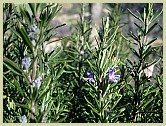The Rosemary Herb - Folklore, Myths & Legends and of Course Cooking!!
Of all the herbs and spices, perhaps nothing has touched our souls as much as the rosemary herb (Rosmarinus officinalis). Numerous myths, legends and folklore have sprung up around this most fragrant of plants. And over the ages, it's been a symbol of the most emotional aspects of the human condition: love, memory, and death.
To read much more about the plant, history, medicinal benefits and general information on this fascinating herb, see the bottom of the page or click the Thumbnail Images.
Links and Info on the Rosemary Herb
Further Information
Originally native to the Mediterranean region, the name, translated from Latin, means"dew of the sea", and its thought this name comes from its ability to survive on the moisture, or "dew", carried on just sea breeze.
The rosemary herb came to express the memory of love and affection, and to symbolize the painful memories after death. In Shakespeare’s Hamlet, Ophelia says “There’s rosemary; that’s for remembrance," in her Garland Speech.

Legend has it that the flowers gained their gentle shade of blue when the virgin Mary, whilst resting, spread her blue cloak on a rosemary bush and the previously white flowers had changed to the colour of her cloak!
The Many Culinary Uses...
It's a vital part of a bouquet garni. A sprig or two adds fabulous flavours to your roast potatoes or oven cooked root vegetables.
Stick a few sprigs into your meat or poultry prior to roasting, or simply add a few chopped leaves to soups, stews and casseroles.
One recommended way of using it is to make a super healthy herbal tea from the fresh or dried leaves. (Recipe above)
Image Links to Other Herb Pages You May Enjoy
Medicinal and Culinary
|
Tips on Growing and
|
Tips and Info on
|
Click on the buttons above to follow me on your favourite social media:
by
Jason Pitcher

Sign up to my monthly newsletter and get a
FREE Book!
Click on the buttons above to follow me on your favourite social media:
















New! Comments
Have your say about what you just read! Leave me a comment in the box below.